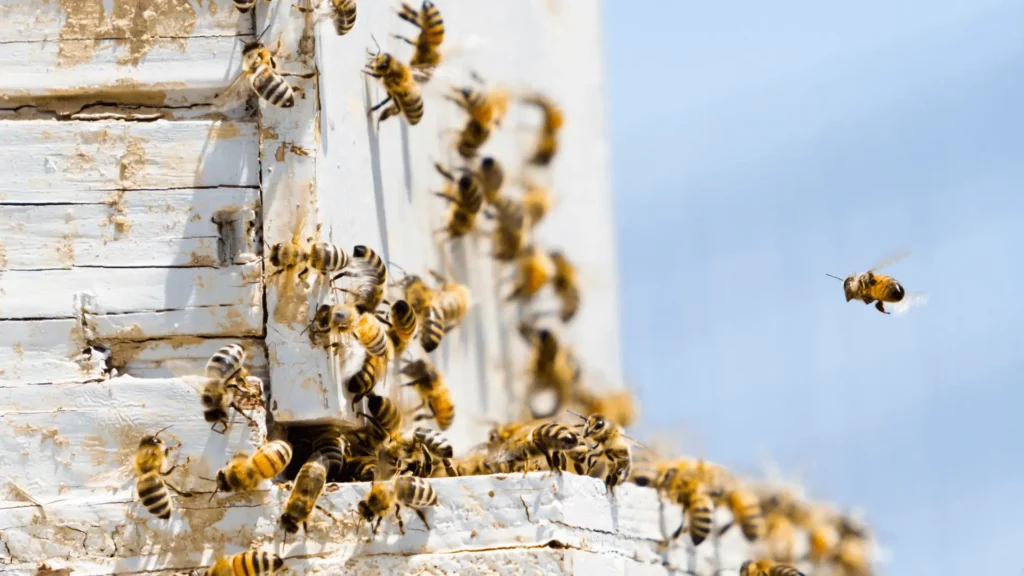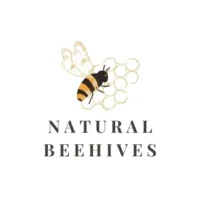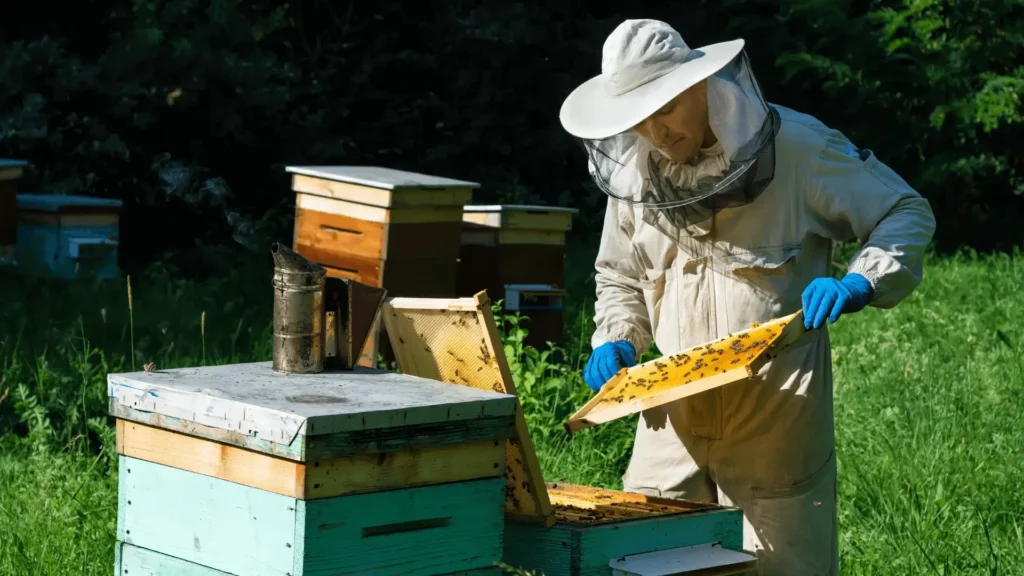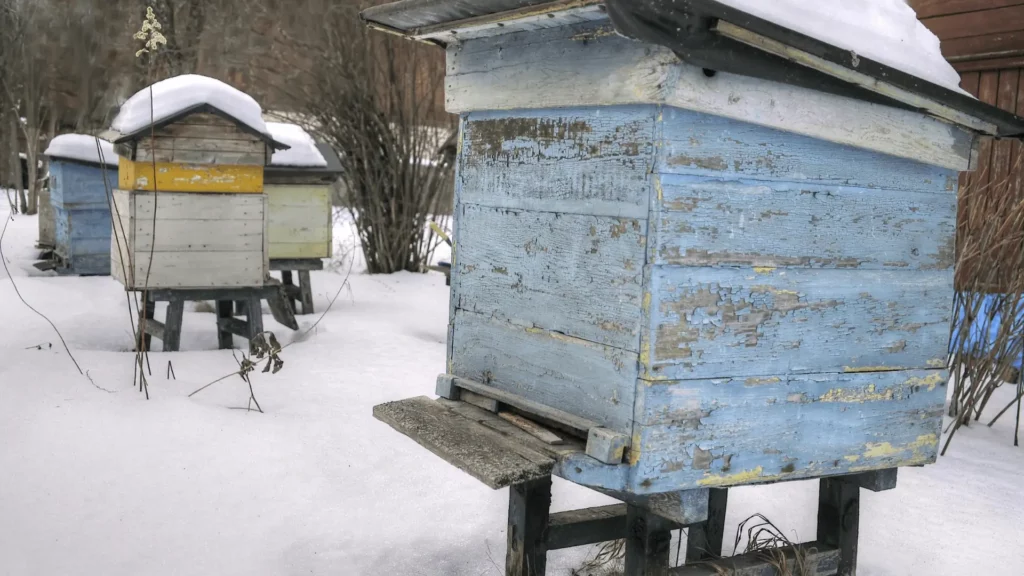
Step into the captivating world of medieval beekeeping, where honey and beeswax flowed like liquid gold and the secrets of the hive were guarded with care. In this article, we will unravel the mysteries of this nuanced and fascinating profession, shedding light on the techniques, attire, and contributions of medieval beekeepers.
Imagine yourself in a bustling medieval marketplace, surrounded by the sweet aroma of honey and the vibrant colors of beeswax candles. Picture the bustling hives, carefully tended to by skilled beekeepers who understood the delicate balance of nature and the art of beekeeping.
But why does medieval beekeeping matter? What insights can we gain from studying this ancient practice? Keep reading as we explore the role of beekeeping in medieval society, from its impact on the local economy to its widespread use in cuisine, medicine, and religious practices.
Discover the challenges faced by medieval beekeepers and their strategies for swarm management and disease control. Delve into the enduring legacy of their practices, which continue to shape modern beekeeping.
Introduction to Medieval Beekeeping
Beekeeping held a pivotal role during the Middle Ages, contributing to the economy, culture, and even religion of the time. As an essential agricultural practice, beekeeping provided a valuable source of honey, beeswax, and other bee-related products that were highly sought after. Medieval beekeepers, known as apiarists, were responsible for the management and maintenance of beehives, ensuring the production of these coveted resources.
The honey produced by medieval beekeepers was not only a delicious sweetener but also served as a vital preservative for food, especially in regions where sugar or alternative sweeteners were scarce or expensive. Additionally, honey was used extensively in traditional medicine practices, valued for its antibacterial properties, wound healing abilities, and soothing effects on coughs and sore throats.
Beeswax, another prized product of medieval beekeeping, played a crucial role in illuminating the dark ages. Candles made from beeswax provided a much-needed source of light during a time when alternative illumination options were limited. The clean, bright flame of beeswax candles made them a preferred choice for religious ceremonies, adding a touch of solemnity and reverence to churches and monasteries.
Medieval beekeepers honed specific techniques and employed various tools to manage their hives and maximize honey production. These techniques included swarm management, the process of preventing or controlling the natural division of bee colonies. By carefully observing bee behavior and implementing strategies to prevent swarming, beekeepers could ensure the stability and productivity of their hives.
The medieval beekeeper’s attire, often consisting of protective clothing made from materials such as linen or leather, served as a shield against bee stings. The distinctive clothing not only offered practical protection but also acted as a symbol of the beekeeper’s profession, emphasizing their expertise and dedication.
By understanding the role of medieval beekeepers in society, we gain insight into the economic impact and cultural significance of beekeeping during the Middle Ages. The trade flourished in various regions, with countries like France, Germany, England, Spain, Italy, and Eastern Europe becoming hubs of beekeeping activity.
As we delve deeper into the secrets of medieval beekeeping, we uncover the challenges faced by beekeepers, their techniques and tools, and the enduring legacy that has shaped modern beekeeping practices. Read on to discover the remarkable contributions of these diligent apiarists.
Did Medieval People Use Sugar for Sweetening?
During the medieval period, sugar was a luxury item that was not readily available to the general population. Instead, medieval people used alternative sweeteners to satisfy their cravings for sweetness. Honey was the most common substitute for sugar and was widely used for sweetening food and beverages. It was easily accessible and often produced locally, making it a valuable commodity. Additionally, fruits such as dates and figs were used to add natural sweetness to dishes. These alternatives provided the desired sweet taste while also offering additional nutritional benefits. The widespread use of sugar in medieval times was limited to the upper classes and was considered a symbol of wealth and status.
Importance of Honey and Beeswax
During the medieval period, honey and beeswax held immense value and played crucial roles in various aspects of daily life. Their significance extended beyond culinary uses and encompassed medicine, religious practices, and even trade.
Versatile Uses of Honey
Honey served as a natural sweetener and preservative, allowing medieval communities to enhance the flavors of their dishes and extend the shelf life of perishable foods. Moreover, honey was a key ingredient in traditional medicines, believed to possess healing properties and used to treat ailments ranging from sore throats to wounds.
Beeswax: A Multi-Purpose Resource
Beeswax, with its malleability and adhesive qualities, was highly coveted during this era. It played a vital role in the production of candles, providing a chief source of light for households and religious ceremonies. Additionally, beeswax was utilized in the creation of various products, including cosmetics, polishes, and ointments.
The honey and beeswax produced by medieval beekeepers not only satisfied the demand for these commodities but also contributed to the local economy. Their trade networks extended throughout regions known for flourishing beekeeping practices, such as the Mediterranean, England, and Eastern Europe.
The enduring allure and benefits of honey and beeswax have transcended time, with these natural resources continuing to hold value today. Understanding their importance during the medieval period provides insights into the ingenuity and resourcefulness of these skilled beekeepers.
Honey in Cuisine and Medicine
Honey played a significant role in both medieval cuisine and traditional medicine practices. Its versatility and medicinal properties made it a prized ingredient in various dishes and remedies. Here are some highlights:
In Medieval Cuisine:
– Sweetening Alternative: During medieval times, sugar was a luxury item and not widely available. Therefore, honey served as the primary sweetener in many recipes.
– Versatile Ingredient: Honey featured in a range of dishes, from sweet pastries and mead (a fermented honey beverage) to savory sauces and glazes.
– Preservation Aid: Its natural antimicrobial properties helped preserve fruits and other perishable foods.
– Traditional Recipes: Honey was used in traditional medieval delicacies such as hypocras (spiced wine), gingerbread, and marzipan.
In Traditional Medicine:
– Healing Properties: Honey was valued for its antimicrobial, anti-inflammatory, and soothing effects on wounds and sore throats.
– Cough Suppressant: Medieval physicians recognized honey’s ability to alleviate coughs and respiratory discomfort.
– Medicinal Elixirs: Honey was infused with herbs and botanicals to create remedies and tonics for various ailments.
– Digestive Aid: It was believed to aid digestion and promote a healthy gut.
Beeswax: Illuminating the Dark Ages
During the Middle Ages, beeswax played a crucial role in providing illumination and lighting up the often dim and dark living spaces of the era. This versatile substance, derived from beehives, offered a safer and more efficient alternative to other lighting methods available at the time.
The Candle-Making Process
Beeswax candles were crafted by melting and purifying the wax obtained from beehives. The process involved carefully separating impurities to ensure the resulting wax was pure and of high quality. Once purified, the beeswax was molded into candles of various shapes and sizes, depending on the needs and resources of the people.
High Quality and Gentle Glow
Compared to other lighting sources, beeswax candles emitted a gentle, warm glow, creating a soothing ambiance in medieval homes, castles, and monasteries. The purity of the beeswax ensured a clean and consistent burn, without the excess smoke or fumes often associated with other materials.
Symbolic Significance
Beyond their practical use, beeswax candles held symbolic importance in religious ceremonies and rituals during the Middle Ages. The pure and pristine nature of beeswax was believed to represent divinity, making it the preferred choice for religious events and spaces.
A Testament to Craftsmanship
The art of candle making using beeswax showcased the craftsmanship and skills of medieval artisans. Intricate designs and patterns were often carved into the candles, transforming these functional objects into beautiful decorative pieces.
Enduring Legacy
The use of beeswax candles during the Middle Ages left an indelible mark on the cultural and historical landscape. Even today, beeswax candles continue to be prized for their elegance, natural scent, and clean burn, connecting us to the traditions and practices of our medieval predecessors.
The Techniques and Tools of the Trade
Medieval beekeepers possessed a skillset honed over generations, utilizing specialized techniques and tools to tend to their hives. Their expertise was crucial in ensuring the productivity and survival of their bee colonies. Let’s delve into the fascinating world of these beekeeping artisans and uncover the methodologies they employed.
Smoking the Bees
One of the most essential techniques employed by medieval beekeepers was the use of smoke. By burning various materials like moss, burlap, or dried leaves, they created a dense smoke that would calm the bees. This smoke served two important purposes: it masked the bees’ alarm pheromones, preventing them from becoming aggressive, and it encouraged the bees to gorge on honey in preparation for a possible evacuation.
Hive Manipulation
Medieval beekeepers skillfully manipulated the hives to manage and maintain their bee colonies. They used techniques such as hive splitting, which involved separating a strong hive into two or more weaker ones to prevent overcrowding and the outbreak of diseases. Additionally, they practiced swarm control by carefully inspecting colonies for signs of swarm preparation and taking appropriate measures to prevent the loss of valuable worker bees.
Traditional Hive Designs
Medieval beekeepers typically used straw or wicker baskets, known as skeps, as their primary beehives. These skeps provided a dark and protected environment for the bees, mimicking the conditions of a natural tree cavity. While skeps lacked movable frames, they served as effective homes for bees and allowed for easy transportation.
Beekeeping Tools
Medieval beekeepers relied on a variety of tools to assist them in their craft. One such tool was the bee brush, typically made of horsehair or feathers, which enabled them to gently sweep bees off combs during hive inspections. They also used a tool called a smoker, mentioned earlier, along with a hive tool to pry apart hive components for inspections or honey extraction.
Protective Attire
While medieval beekeepers didn’t have access to the modern beekeeper suits we use today, they still needed protection from bee stings. They would wear clothing made of thick fabric, such as wool or leather, along with gloves and a hat with a veil. This attire provided some defense against bee stings, allowing them to work with the hives more comfortably.
Skeps: The Classic Beehive
The traditional beehive design known as a “skep” was widely used by medieval beekeepers. These domed structures were typically made from straw or wicker and provided a cozy and protected environment for the bees. The skep beehives were an integral part of medieval beekeeping practices, allowing beekeepers to easily observe and manage their colonies.
The construction of a skep involved tightly weaving straw or wicker around a circular base, gradually building up the walls and creating a hollow cavity inside. These hives were designed to mimic the natural cavities where bees would typically establish their colonies. The size and shape of the skep contributed to its functionality and durability in different weather conditions.
Medieval beekeepers valued skeps for their simplicity and portability. They could be easily transported to different locations, allowing beekeepers to take advantage of diverse foraging opportunities for their bees. Additionally, the design of the skep helped with insulation, protecting the bees during the colder months.
However, despite their practicality, skeps had certain limitations. Harvesting honey from a skep beehive was a challenging process, often involving the destruction of the hive. This led to the development of more modern beehive designs that prioritize bee health and sustainable honey harvesting techniques.
Although the use of skeps as beehives has declined over time, they remain a symbol of medieval beekeeping and the fascinating history of this ancient craft. The legacy of the skep lives on in modern beekeeping practices, serving as a reminder of the ingenuity and resourcefulness of medieval beekeepers.
Harvesting Honey
Harvesting honey from beehives during the medieval period was a meticulous and labor-intensive process. Beekeepers approached this task with care and precision, considering the importance of honey as a valuable commodity.
To extract honey, medieval beekeepers employed a variety of methods. One common approach involved using smoke to calm the bees and make them less aggressive. Beekeepers would then carefully remove frames or sections of comb containing ripe honey. The extracted combs were gently crushed to release the honey, which would then be strained to remove impurities.
However, harvesting honey came with its challenges. Bee stings were an ever-present threat, requiring beekeepers to wear protective attire. Additionally, adverse weather conditions, such as heavy rain, posed risks to both beekeepers and the bee colonies.
Despite the difficulties, medieval beekeepers recognized the importance of harvesting honey and the constant demand for this golden delicacy. Their efforts contributed to the availability of honey in medieval cuisine, medicine, and even religious practices.
Swarm Management: Strategies of Medieval Beekeepers
Medieval beekeepers developed various strategies to effectively manage and control bee swarms, ensuring the stability and productivity of their hives. These techniques allowed them to harness the power of these fascinating creatures while minimizing the risks associated with swarming.
1. Splitting the Hive: When a hive became overcrowded, medieval beekeepers would divide it into two or more colonies. This practice, known as splitting the hive, allowed them to create additional space for the bees and prevent swarming.
2. Providing Extra Supers: Beekeepers would add additional supers, or boxes, to the hive to give the bees more room for expansion. This technique helped alleviate overcrowding and prevented the bees from feeling the need to swarm.
3. Smoking the Bees: Medieval beekeepers would use smoke to calm the bees during hive inspections and swarm prevention. They believed that the smoke mimicked a forest fire, triggering the bees’ natural response to gorge on honey in preparation to leave the hive. This temporary distraction minimized the risk of swarming.
4. Queen Bee Management: Beekeepers carefully managed the queen bee in the hive to prevent swarming. They would replace an aging queen with a new one to maintain a strong and stable colony. By keeping a young and vigorous queen, beekeepers ensured a healthier hive and reduced the inclination to swarm.
5. Providing Suitable Hive Conditions: Beekeepers would ensure that the hive had sufficient ventilation, proper insulation, and adequate food stores. By maintaining optimal hive conditions, they minimized stress on the bees and reduced the likelihood of swarming.
6. Timely Harvesting: Beekeepers would timely harvest honey from their hives. By regularly taking honey, they created more space for the bees, preventing overcrowding and the trigger for swarming.
7. Bee Stock Selection: Some medieval beekeepers selectively bred bees that were less prone to swarm. By focusing on traits such as docility and productivity, they aimed to breed colonies that were more stable and less inclined to swarm.
These swarm management strategies employed by medieval beekeepers allowed them to maintain control over their hives and sustain a productive and stable beekeeping practice. They understood the delicate balance of a hive and employed techniques to prevent the loss of a swarm, ensuring a steady supply of honey and beeswax for their medieval communities.
Also read: Beekeepers Toolbox Essentials: Practical Must-Haves for Successful Beekeeping
Medieval Beekeeper Attire
Medieval beekeepers, known as apiarists, had a distinctive attire that reflected the unique challenges of their trade. Donning protective garments was crucial to shield themselves from bee stings and ensure a successful beekeeping operation.
Protective Clothing
Beekeepers in the Middle Ages typically wore a combination of sturdy garments made from thick fabric and leather. A common outfit consisted of a long tunic, reinforced with thick padding, to protect against bee stings. The tunic was often accompanied by matching trousers or leggings for full-body coverage.
Protective Headgear
To safeguard their heads and faces, medieval beekeepers used a variety of headgear options. The most recognizable piece was the straw hat, which featured a wide brim to shield the face from both the scorching sun and the bees’ buzzing wings. Additionally, they often wore a sturdy cloth hood that could be tucked into the collar of their tunic, providing extra protection against bee stings.
Gauntlets and Gloves
To protect their hands from bee stings, beekeepers relied on gauntlets or gloves made from thick leather. These specialized hand coverings extended up to the forearm, ensuring complete protection while handling the beehives or extracting honey.
Footwear
Medieval beekeepers chose sturdy, closed-toe shoes or boots to shield their feet from potential bee stings or accidental spills of hot beeswax. The footwear needed to be comfortable enough for extended periods spent tending to the hives and harvesting honey.
The attire of medieval beekeepers not only protected them against bee stings and hot wax but also created an iconic image that has endured throughout history. Through their distinctive clothing, medieval beekeepers showcased their expertise in taming and managing these vital insects.
Also read: The Ultimate Beekeeping Starter Kit: Everything You Need to Get Started
Medieval Beekeepers in Society
Medieval beekeepers played a crucial role in society, leaving a lasting impact on both the economy and culture of the time. Their skills and expertise were highly valued, contributing to the local economy and providing essential resources for various industries. Here, we explore the economic and cultural significance of medieval beekeepers.
Economic Impact
Medieval beekeeping had a direct impact on the local economy, particularly in regions where beekeeping flourished, such as France, Germany, England, Spain, Italy, and Eastern Europe. Honey and beeswax were highly sought-after commodities, used in a wide range of products and industries.
– Trade and Commerce: Beekeepers actively participated in trade networks, supplying honey and beeswax to local markets and even exporting their products to other regions. The honey trade was a significant contributor to economic growth, generating revenue for individuals and communities.
– Artisans and Craftspeople: Beeswax was a valuable material used in the production of candles, cosmetics, and various crafts. Medieval beekeepers supplied beeswax to artisans and craftspeople who relied on it to create beautiful and functional objects.
– Medicine and Apothecaries: Honey had medicinal properties and was used in traditional medicine practices during the Middle Ages. Beekeepers supplied apothecaries and healers with honey, which was used to create remedies for various ailments.
Cultural Significance
Medieval beekeepers also held cultural significance, as their profession was deeply intertwined with daily life and religious practices.
– Religion and Rituals: Bees and beehives held symbolic value in religious practices during the medieval period. Beeswax candles, made from the labor of bees, were used in religious ceremonies and served as a chief light source in churches and monasteries.
– Beekeeping Attire and Customs: Beekeepers had their distinctive attire, often wearing protective clothing to shield themselves from bee stings. Their apparel became a common sight, and their unique role in society was recognized and respected.
– Traditional Knowledge and Folklore: Beekeeping techniques, strategies for swarm management, and the understanding of bee diseases were passed down through generations, creating a rich body of traditional knowledge and folklore.
Medieval beekeepers left an indelible mark on society, contributing to the local economy, shaping cultural practices, and also fostering innovation and advancements in beekeeping techniques. Their legacy continues to resonate even in modern beekeeping practices. The economic and cultural impact of medieval beekeepers is a testament to the enduring importance of this fascinating profession.
Challenges Faced by Medieval Beekeepers
Medieval beekeepers encountered numerous challenges in their profession, navigating the complexities of beekeeping in a time without modern tools and scientific knowledge. Here are some of the main hardships they faced:
1. Limited Understanding of Bee Diseases and Pests
Medieval beekeepers had a limited understanding of bee diseases and pests. They were often unable to identify or effectively treat common ailments that afflicted their hives, such as foulbrood or varroa mites. The lack of knowledge in disease control meant that entire colonies could be lost, leading to significant economic and resource setbacks.
2. Swarm Management
Bee swarms posed a significant challenge for medieval beekeepers. Controlling and preventing swarms was crucial, as it ensured the colony’s survival and prevented potential damages to nearby areas. Beekeepers had to employ various techniques, such as providing ample space in hives and using smoke to calm the bees during swarm season.
3. Environmental Factors
Medieval beekeepers had to contend with unpredictable weather conditions that directly affected honey production. Adverse weather events, such as heavy rain or extreme temperatures, could disrupt the foraging patterns of bees, impacting both honey yield and the overall health of the colony.
4. Limited Tools and Equipment
Unlike modern beekeepers who have access to an array of specialized tools and protective gear, medieval beekeepers had to rely on rudimentary tools, such as wooden hives and basic smoking devices. These limitations made certain tasks, like honey extraction and hive inspections, more challenging and time-consuming.
5. Bee Stings and Safety
Bee stings were an unavoidable hazard for medieval beekeepers. They had to endure stings while working with the bees, often without the protection of modern beekeeper suits. While bee stings were seen as a regular part of the job, they still posed a risk of infection or allergic reactions.
Despite these challenges, medieval beekeepers persevered, utilizing their limited knowledge and resources to sustain honey production and contribute to the local economy. Their dedication and ingenuity laid the foundation for the evolving art of beekeeping that we know today.
Countries with the Most Medieval Beekeeping
Medieval beekeeping was a thriving practice in various regions and countries, contributing to local economies and cultural traditions. Let’s explore some of the key areas where beekeeping flourished during this period.
France: A Hub of Beekeeping Activity
France emerged as a significant hub for medieval beekeeping, particularly in the Mediterranean region. The country’s favorable climate and abundant flora provided ideal conditions for bee colonies to thrive. Beekeeping played a crucial role in French society, providing honey for consumption, wax for candles, and even mead production.
Germany: Rich Tradition and Innovations
Germany also had a rich tradition of beekeeping during the Middle Ages. Beekeepers in Germany developed innovative approaches to swarm management and disease control, ensuring the health and productivity of their hives. The country’s strong beekeeping heritage persists to this day, with modern beekeepers building upon the knowledge and techniques passed down through generations.
England: Bees in the Medieval Landscape
In England, beekeeping was a common practice, especially in rural areas. Beekeepers played an essential role in pollinating crops and producing honey for personal use and trade. The medieval English landscape was dotted with hives, and honey was used in various culinary preparations and medicinal concoctions.
Spain: A Sweet Legacy
With its warm climate and abundant floral resources, Spain fostered a thriving beekeeping industry during the Middle Ages. Beekeepers in Spain harnessed the medicinal properties of honey and utilized beeswax for candle-making, illuminating the daily lives of medieval Spaniards.
Italy: Beekeeping and the Renaissance
In Italy, beekeeping flourished during the medieval era, and its practice extended well into the Renaissance period. Beekeepers in Italy were known for their understanding of bee diseases and their meticulous hive management techniques. Beeswax candles were widely used in churches, leaving an indelible mark on the religious and cultural practices of the time.
Eastern Europe: A Strong Beekeeping Tradition
Eastern Europe, including countries like Poland, Hungary, and Romania, had a long and deep-rooted tradition of beekeeping. The region’s forests and meadows provided ample forage for bees, making it an ideal location for apiarists. Honey production and trade were integral to the local economy, with beekeeping serving as a particularly critical part of agricultural practices.
Medieval beekeeping left an enduring legacy in these regions and countries, shaping local economies, culinary traditions, and even religious practices. Today, we can appreciate the advancements made by medieval beekeepers and their valuable contributions to society.
Legacy and Evolution
Medieval beekeeping has left an indelible mark on the history of apiariculture. Its enduring legacy can be seen in the evolution of beekeeping practices over time. From the medieval period to the present day, beekeeping has undergone various changes, influenced by advancements in technology and a deeper understanding of bee diseases.
The Evolution of Beekeeping Techniques
In medieval times, beekeepers relied on traditional hive designs, such as the classic “skep.” These dome-shaped straw or wicker hives provided a suitable habitat for bees. However, with the passage of time, beekeepers began adopting more advanced hive designs that allowed for better disease control and easier honey extraction.
The Influence of Beekeeping on Society
During the Middle Ages, beekeeping played a substantial role in the local economy and everyday life. It was not only a source of honey and beeswax but also provided employment opportunities and trade routes. Medieval beekeepers were highly regarded for their expertise, and their practices shaped the development of apiculture in various regions, particularly in France, Germany, England, Spain, Italy, and Eastern Europe.
Modern Innovations and Challenges
In the modern era, beekeeping has benefited from advanced materials and technology. Beekeepers now have access to protective clothing, modern hive designs, and tools that make the management of bee colonies more efficient. However, the challenges faced by medieval beekeepers, such as bee diseases and swarm management, still persist. With the advancement of scientific knowledge, efforts are being made to understand and combat these challenges.
The Enduring Significance
Medieval beekeeping has left a lasting legacy, both culturally and practically. Today, honey and beeswax continue to be in constant demand for various purposes, from culinary delights to medicinal properties. The art of beekeeping, rooted in humanity’s oldest agricultural practice, carries on the traditions established by medieval beekeepers. By honoring their legacy and adapting to new insights, modern beekeepers ensure that the ancient bond between humans and bees endures.
Also read: Buzz with Confidence: The Ultimate Beehive Selection Guide for Novice Beekeepers
Conclusion
Medieval beekeeping holds a significant place in history as one of humanity’s oldest agricultural practices. Beekeepers of the time played a crucial role in society, contributing to the economy, culture, and even religion. The captivating world of medieval beekeepers is filled with intriguing techniques, attire, and trade secrets.
The legacy of medieval beekeeping can be seen in the enduring demand for honey and beeswax. From the sweetening of medieval cuisine to the use of honey in traditional medicine practices, these natural products were valued for their medicinal properties and rich flavor profiles.
In addition to their contributions to various aspects of medieval life, beekeepers faced numerous challenges. Swarm management and disease control were critical for maintaining the health of bee colonies. Beekeepers’ attire, designed to protect against bee stings, reflected their deep understanding of these natural phenomena.
Throughout the Middle Ages, regions such as France, Germany, England, Spain, Italy, and Eastern Europe became hubs of beekeeping activity. These areas embraced the art of beekeeping, leaving an indelible mark on their histories.
Today, we continue to benefit from the advanced materials and techniques developed by medieval beekeepers. The modern beekeeper suit, for example, can be traced back to the unique attire worn by medieval beekeepers.
The knowledge and expertise of medieval beekeepers, passed down through generations, have shaped our understanding of bee diseases and swarm management. The legacy of these ancient beekeepers lives on in our practices and innovations.



